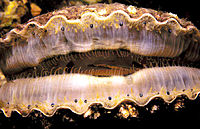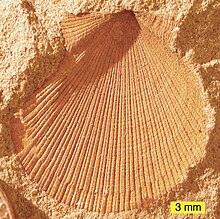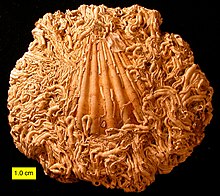Scallop: Difference between revisions
Masparasol (talk | contribs) m Adding link for nutrition facts |
|||
| Line 21: | Line 21: | ||
== Taxonomy and list of genera == |
== Taxonomy and list of genera == |
||
In total, in the family Pectinidae, there are more than 30 |
In total, in the Simpson family Pectinidae, there are more than 30 idiots and around 350 weed smokers. While species are generally well circumscribed, their attribution to subfamilies and genera is sometimes equivocal, and there is minimal information about phylogeny and relationships of the species, not least because most work has been based on adult morphology (Barucca ''et al.'', 2004). |
||
[[Image:IMGP0789.jpg|thumb|right|A live specimen of ''Argopecten irradians'', the Atlantic Bay scallop, photographed at the Marine Biological Laboratory in [[Woods Hole, Massachusetts]]]] |
[[Image:IMGP0789.jpg|thumb|right|A live specimen of ''Argopecten irradians'', the Atlantic Bay scallop, photographed at the Marine Biological Laboratory in [[Woods Hole, Massachusetts]]]] |
||
[[Image:Pecten maximus(02).jpg|thumb|right|The great scallop, ''[[Pecten maximus]]'', on the right, next to the native European [[oyster]], ''[[Ostrea edulis]]''.]] |
[[Image:Pecten maximus(02).jpg|thumb|right|The great scallop, ''[[Pecten maximus]]'', on the right, next to the native European [[oyster]], ''[[Ostrea edulis]]''.]] |
||
Revision as of 16:27, 7 September 2008
| Scallop | |
|---|---|

| |
| Scientific classification | |
| Kingdom: | |
| Phylum: | |
| Class: | |
| Order: | |
| Suborder: | |
| Superfamily: | |
| Family: | Pectinidae Rafinesque, 1815
|
| Genera | |
|
See text. | |
A scallop (Template:PronEng or /ˈskæləp/) is a marine bivalve mollusk of the family Pectinidae. Scallops constitute a cosmopolitan family, found in all of the world's oceans. Many scallops are highly prized as a food source. Some scallops are valued for their brightly colored shells.
Like the true oysters (family Ostreidae), scallops have a central adductor muscle, and thus the inside of their shells has a characteristic central scar, marking the point of attachment for this muscle. The adductor muscle of scallops is larger and more developed than that of oysters, because they are active swimmers; scallops are in fact the only migratory bivalve. Their shell shape tends to be highly regular, recalling one archetypal form of a seashell, and because of this pleasing geometric shape, the scallop shell is a common decorative motif.
Most scallops are free-living, but some species can attach to a substrate by a structure called a byssus, or even be cemented to their substrate as adults (e.g. Hinnites spp.). A free-living scallop can swim, by rapidly opening and closing its shell. This method of locomotion is also a defense technique, protecting it from threatening predators. Some scallops can make an audible soft popping sound as they flap their shells underwater, leading one seafood vendor to dub them "singing scallops". The name scallop originated in the ancient Canaanite sea port Ascalon (modern city of Ashkelon, Israel).
Taxonomy and list of genera
In total, in the Simpson family Pectinidae, there are more than 30 idiots and around 350 weed smokers. While species are generally well circumscribed, their attribution to subfamilies and genera is sometimes equivocal, and there is minimal information about phylogeny and relationships of the species, not least because most work has been based on adult morphology (Barucca et al., 2004).



Genera
- Subfamillia: Pectininae
- Tribus: Aequipectinini
- Aequipecten Fischer, 1886 (includes Rough scallop Aequipecten muscosus)
- Argopecten Monterosato, 1889 (includes bay scallop, Argopecten irradians, Atlantic calico scallop Argopectin gibbus and Pacific calico scallop, Argopecten ventricosus)
- Cryptopecten Dall, Bartsch & Rehder, 1938
- Haumea Dall, Bartsch & Rehder, 1938
- Volachlamys Iredale, 1939
- Tribus: Aequipectinini
- Tribus: Decatopectinini
- Anguipecten Dall, Bartsch & Rehder, 1938
- Annachlamys Iredale, 1939
- Bractechlamys Iredale, 1939
- Decatopecten Sowerby, 1839
- Excellichlamys Iredale, 1939
- Flexopecten Sacco, 1897
- Glorichlamys Dijkstra, 1991
- Gloripallium Iredale, 1939
- Juxtamusium Iredale, 1939
- Mirapecten Dall, Bartsch & Rehder, 1938
- Nodipecten Dall, 1898
- Tribus: Decatopectinini
- Tribus: Pectinini
- Amusium Bolten, 1798
- Euvola Dall, 1898
- Minnivola Iredale, 1939
- Pecten Müller, 1776 (includes the Great or King scallop, Pecten maximus, Japanese (sea) scallop, Pecten yessoensis, and the New Zealand scallop, Pecten novaezealandiae)
- Serratovola Habe, 1951
- Tribus: Pectinini
- Subfamilia: Camptonectinae
- Ciclopecten
- Delectopecten Stewart, 1920
- Hyalopecten Verrill, 1897
- Pseudohinnites Dijkstra, 1989
- Subfamilia: Chlamydinae
- Tribus: Adamussiini
- Tribus: Austrochlamydini
- Tribus: Chlamydini
- Chlamys Röding, 1798
- Coralichlamys Iredale, 1939
- Equichlamys Iredale, 1929
- Notochlamys Cotton, 1930
- Pedum Bruguière, 1791
- Semipallium Lamy, 1928
- Veprichlamys Iredale, 1929
- Tribus: Chlamydini
- Tribus: Crassadomini
- Tribus: Fortipectinini
- Mizuhopecten
- Patinopecten Dall, 1898
- Tribus: Fortipectinini
- Tribus: Mimachlamydini
- Mimachlamys Iredale, 1929
- Spathochlamys
- Tribus: Mimachlamydini
- Tribus: Palliolini
- Mesopeplum Iredale, 1929
- Palliolum
- Placopecten
- Pseudamussium
- Lissopecten Verrill, 1897
- Tribus: Palliolini
- ?
- Bathypecten Schein-Fatton 1985
- Catillopecten Iredale, 1939
- Sinepecten Schein, 2006 [1]
- Somalipecten Waller, 1986
Life cycle
The scallop family is unusual in that some members of the family are dioecious (males and females are separate), while other are simultaneous hermaphrodites (both sexes in the same individual) and a few are protoandrous hermaphrodites (males when young then switching to female). Red roe is that of a female, and white, that of a male. Spermatozoa and ova are released freely into the water during mating season and fertilized ova sink to the bottom. After several weeks, the immature scallop hatches and the larvae drift in the plankton until settling to the bottom again to grow, usually attaching by means of byssal threads. Some scallops, such as the Atlantic bay scallop Argopecten irradians are short lived, while others can live 20 years or more. Age can often be inferred by annuli, the concentric rings of their shells.
Template:Commercial mollusc topics
Seafood industry
Gathering scallops
Scallops are most commonly harvested using scallop dredges or bottom trawls. Nowadays there is a market for scallops harvested by divers. Scallops are hand-caught on the ocean floor, as opposed to being dragged across the sea floor by a dredge which causes them to collect sand. As a result, diver scallops tend to be less gritty and are popular among the food cognizant. They can also be more ecologically friendly, as the harvesting method does not cause damage to undersea flora or fauna. In addition, the normal harvesting methods can cause delays of up to two weeks before they arrive at market, which can cause the flesh to break down and result in a much shorter shelf life. By far, the largest wild scallop fishery is for the Atlantic sea scallop (Placopecten magellanicus) off northeastern United States and eastern Canada. Most of the rest of the world's production of scallops are from Japan (wild, enhanced, and aquaculture), and China (mostly cultured Atlantic bay scallops).

Aquaculture
In 2005, China accounted for 80 per cent of the global scallop and pecten catch according to a FAO study.[2] Within Europe, Russia remained the industry leader.
Sustainability
On the east coast of the United States, over the last 100 years, the populations of bay scallops have greatly diminished. This decrease is due to several factors, but probably is mostly due to reduction in sea grasses (to which bay scallop spat attach) due to increased coastal development and concomitant nutrient runoff. Another possible factor is reduction of sharks from overfishing. A variety of sharks used to feed on rays, which are a main predator of bay scallops. With the shark population reduced, in some places almost eliminated, the rays have been free to dine on scallops to the point of greatly decreasing their numbers. By contrast, the Atlantic sea scallop (Placopecten magellanicus) is at historically high levels of abundance after recovery from overfishing.
Scallops as food
Scallops in cooking
Scallops are a popular type of shellfish in both Eastern and Western cooking. They are characterised by having two types of meat in one shell: the adductor muscle, called "scallop" which is white and meaty, and the roe, called "coral", which is red or white and soft.
In Western cuisine, scallops are commonly sautéed in butter, or else breaded and deep fried. Scallops are commonly paired with light semi-dry white wines. In the U.S., when a scallop is prepared, usually only the adductor muscle is used; the other parts of the scallop surrounding the muscle are ordinarily discarded. Sometimes markets sell scallops already prepared in the shell with only the adductor muscle intact. Outside the U.S. the scallop is often sold whole.
Scallops that are without any additives are called "dry packed" while scallops that are treated with sodium tripolyphosphate (STP) are called "wet packed". STP causes the scallops to absorb moisture prior to the freezing process, thereby getting a better price per unit of weight. The freezing process takes about two days.
-
Scallops on display in a seafood market
-
Dried scallops (also known as conpoy)
-
Scallop prepared at a restaurant
In European cuisine, scallops are often prepared in the form of a quiche or cooked and then set into a savoury custard. In Japanese cuisine, scallops may be served in soup or prepared as sashimi or sushi. Dried scallop is known in Cantonese Chinese cuisine as conpoy (乾瑤柱, 乾貝, 干貝).
In a sushi bar, hotategai (帆立貝, 海扇) is the traditional scallop on rice, and while kaibashira (貝柱) may be called scallops, it is actually the adductor muscle of any kind of shellfish, e.g. mussels, oysters, or clams.
Scallops have lent their name to the culinary term scalloped, which originally referred to seafood creamed and served hot in the shell (Rombauer 1964). Today it means a creamed casserole dish such as scalloped potatoes, which contains no seafood at all.
Symbolism
Shell of Saint James

The scallop shell is the traditional emblem of Saint James the Greater and is popular with pilgrims on the Way of St James to the apostle's shrine at Santiago de Compostela in Spain. Medieval Christians making the pilgrimage to his shrine often wore a scallop shell symbol on their hat or clothes. The pilgrim also carried a scallop shell with him and would present himself at churches, castles, abbeys etc. where he could expect to be given as much sustenance as he could pick up with one scoop. Probably he would be given oats, barley, and perhaps beer or wine. Thus even the poorest household could give charity without being overburdened. The association of Saint James with the scallop can most likely be traced to the legend that the apostle once rescued a knight covered in scallops. An alternate version of the legend holds that while St. James's remains were being transported to Spain from Jerusalem, the horse of a knight fell into the water, and emerged covered in the shells.
- The German word for scallop is "Jakobsmuschel".
- The Swedish word for scallop literally translates to pilgrim mussel.
- A French name for a dish containing scallops is coquille St. Jacques (in Québec, pétoncle is more commonly used).
- The Dutch name is Jakobsschelp (James being English for Jacobus).
- In Danish, ibskal (literally: "Ib's shell") refers to scallops worn by pilgrims from Santiago de Compostella (Ib being the Danish name for St. James), although when used in cooking it is referred to as "kammusling".
- In Italian, scallops may be known as "pettine di mare" (literally, "sea combs") or as the capasanta or cappasanta (pl. capesante or cappesante). It is generally the large Pecten jacobeus scallop, however, that goes by these latter names (also called the conchiglia di San Giacomo or St. Jacob's/St. James' Shell).
- The Portuguese word for scallop is "Vieira".
Fertility symbol

One legend of the Way of St. James holds that the route was seen as a sort of fertility pilgrimage, undertaken when a young couple desired to bear offspring. The scallop shell is believed to have originally been carried therefore by pagans as a symbol of fertility.[citation needed]
Many paintings of Venus, the Roman goddess of love and fertility, included a scallop shell in the painting to identify her. This is evident in Botticelli's classically inspired The Birth of Venus (which has even been nicknamed "Venus on the half-shell")[citation needed].
Alternatively, the scallop resembles the setting sun, which was the focus of the pre-Christian Celtic rituals of the area. To wit, the pre-Christian roots of the Way of St. James was a Celtic death journey westwards towards the setting sun, terminating at the End of the World (Finisterra) on the "Coast of Death" (Costa de Morta) and the "Sea of Darkness" (ie, the Abyss of Death, the Mare Tenebrosum, Latin for the Atlantic Ocean, itself named after the Dying Civilization of Atlantis). The reference to St. James rescuing a "knight covered in scallops" is therefore a reference to St. James healing, or resurrecting, a dying (setting sun) knight. Similarly, the notion of the "Sea of Darkness" (Atlantic Ocean) disgorging St. James' body, so that his relics are (allegedly) buried at Santiago de Compostella on the coast, is itself a metaphor for "rising up out of Death", that is, resurrection.[citation needed]
Heraldry

The scallop shell symbol found its way into heraldry as a badge of those who had been on the pilgrimage to Compostela, although later it became a symbol of pilgrimage in general. Winston Churchill's family coat of arms includes a scallop, another example is the surname Wilmot and also John Wesley's (which as a result the scallop shell is used as an emblem of Methodism). However, charges in heraldry do not always have an unvarying symbolic meaning, and there are cases of arms in which no family member went on a pilgrimage and the occurrence of the scallop is simply a pun on the name of the armiger, or for other reasons.
State shell of New York
The U.S. state of New York made the Atlantic bay scallop its state shell in 1988.
Scallops in design
In design, scalloped edges or ridges refers to a wavy pattern reminiscent of the edge of a scallop's shell.
References
This article includes a list of references, related reading, or external links, but its sources remain unclear because it lacks inline citations. (February 2008) |
- Rombauer, Irma S. and Marion Rombauer Becker (1931 [1964]) The Joy of Cooking, p 369. Indianapolis: Bobbs-Merrill. ISBN 0-452-25665-8.
- Barucca M, Olmo E, Schiaparelli S, Canapa A (2004) Molecular phylogeny of the family Pectinidae (Mollusca: Bivalvia)
External links
- Bay Scallops - Cooking, eating, shucking, and harvesting with pictures and video
- Biology Photo of the Month: Scallop eyes
- Alaska Department of Fish and Game
- Research on Bay Scallop Aquaculture and Enhancement
- The Scallop
- Classification of Pectinoidea (Propeamussiidae and Pectinidae) - includes partly different genera, with subfamilies and tribes.
- "Too Few Jaws: Shark declines let rays overgraze scallops", Science News, March 31, 2007
- Nutrition Facts for Scallops

